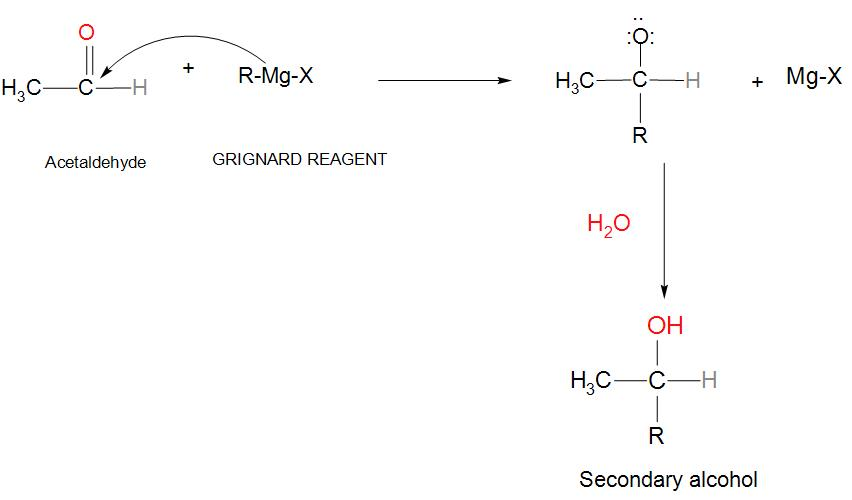
Aldehydes other than formaldehyde react with Grignard’s reagent to give addition products which on hydrolysis give:
A. tertiary alcohols
B. secondary alcohols
C. primary alcohols
D. carboxylic acids
Answer
507.3k+ views
Hint: Aldehyde reacts with Grignard’s reagent to give organometallic compounds. Which on further hydrolysis gives alcohols. Grignard’s reagent is magnesium alkyl halide, which is formed when alkyl halide is reacted with magnesium.
Complete answer:
- We will take an aldehyde like acetaldehyde and react it with Grignard reagent then it will give additional products, which on hydrolysis will give secondary alcohol. We can see the reaction:

- If we take an Aldehyde like acetaldehyde and when it reacts with Grignard’s reagent (that is an alkyl halide mixed with Mg). We can see that the carbonyl carbon of acetaldehyde is having positive charge and the oxygen is having negative charge.
- When it is attacked with Grignard reagent, at that time it will push the double bond between carbon and oxygen to become a lone pair around the oxygen, and we get the product along with Mg-Halide.
- In the next step the products are mixed up with some aqueous acid and we get a secondary alcohol as our main product.
Hence, we can conclude that option (B) is correct, that aldehydes other than formaldehyde react with Grignard’s reagent to give additional products which on hydrolysis give secondary alcohols.
Note:
- All the aldehydes except formaldehyde when reacted with Grignard’s reagent will give secondary alcohol. Formaldehyde will give primary alcohol.
- Ketones also react with Grignard’s reagent to give alcohol.
Complete answer:
- We will take an aldehyde like acetaldehyde and react it with Grignard reagent then it will give additional products, which on hydrolysis will give secondary alcohol. We can see the reaction:

- If we take an Aldehyde like acetaldehyde and when it reacts with Grignard’s reagent (that is an alkyl halide mixed with Mg). We can see that the carbonyl carbon of acetaldehyde is having positive charge and the oxygen is having negative charge.
- When it is attacked with Grignard reagent, at that time it will push the double bond between carbon and oxygen to become a lone pair around the oxygen, and we get the product along with Mg-Halide.
- In the next step the products are mixed up with some aqueous acid and we get a secondary alcohol as our main product.
Hence, we can conclude that option (B) is correct, that aldehydes other than formaldehyde react with Grignard’s reagent to give additional products which on hydrolysis give secondary alcohols.
Note:
- All the aldehydes except formaldehyde when reacted with Grignard’s reagent will give secondary alcohol. Formaldehyde will give primary alcohol.
- Ketones also react with Grignard’s reagent to give alcohol.
Recently Updated Pages
Why are manures considered better than fertilizers class 11 biology CBSE

Find the coordinates of the midpoint of the line segment class 11 maths CBSE

Distinguish between static friction limiting friction class 11 physics CBSE

The Chairman of the constituent Assembly was A Jawaharlal class 11 social science CBSE

The first National Commission on Labour NCL submitted class 11 social science CBSE

Number of all subshell of n + l 7 is A 4 B 5 C 6 D class 11 chemistry CBSE

Trending doubts
What is meant by exothermic and endothermic reactions class 11 chemistry CBSE

10 examples of friction in our daily life

One Metric ton is equal to kg A 10000 B 1000 C 100 class 11 physics CBSE

1 Quintal is equal to a 110 kg b 10 kg c 100kg d 1000 class 11 physics CBSE

Difference Between Prokaryotic Cells and Eukaryotic Cells

What are Quantum numbers Explain the quantum number class 11 chemistry CBSE




